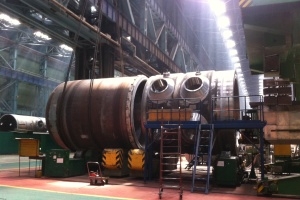Ru
|
Eng
Second reactor vessel for Belarusian nuclear power plant assembled
27.05.2016

The Volgodonsk-based branch of the Russian company AEM Technologies (part of Atomenergomash, which is the mechanical engineering division of the Russian state corporation Rosatom) has finished assembling the reactor vessel for the second power-generating unit of the Belarusian nuclear power plant, the Atomenergomash press service told BelTA.
Preparations for welding the final circumferential seam to connect the upper and lower parts of the reactor vessel are now in progress. It is one of the key operations in manufacturing this piece of equipment. The welding of the circumferential seam will take ten days, with the welding zone constantly heated to over 200C. Once the welding operations are done, the reactor vessel will be put inside a heat-treatment furnace for the final touch.
The production of components to put inside the reactor vessel proceeds in parallel. Specialists have optimized the manufacturing technology to get the internal components ready for the controlled assembly that will include the reactor vessel. Plans have been made to finish making the main components — the shaft, the protective tube unit, and the baffle — within one month, said Vitaly Shishov, Atommash Director of Operations.
The reactor is a vertical cylinder with an elliptical bottom. The reactor core and the internal components are located inside.
Established in 2007, AEM Technologies is part of Atomenergomash. AEM Technologies makes equipment for nuclear energy industry, heat energy industry, gas, oil and chemical industries. AEM Technologies has an engineering division in Saint Petersburg and two manufacturing divisions in Petrozavodsk (Petrozavodskmash) and Volgodonsk (Atommash).
The Belarusian nuclear power plant is a project to build an AES-2006 type nuclear power plant 18km away from Ostrovets, Grodno Oblast. The BelNPP will have two power-generating units with the total output capacity of up to 2,400MW (2x1,200MW). In line with the general contract for building the nuclear power plant the first power-generating unit is scheduled for commissioning in 2018, with the second one to go online in 2020.
BELNPP: NEWS FROM CONSTRUCTION SITE
23.07.2024
11.07.2024
28.06.2024
06.06.2024
04.06.2024
04.06.2024
03.06.2024
24.05.2024
23.05.2024
03.05.2024













